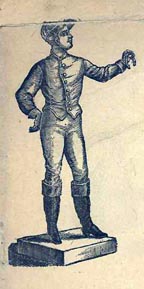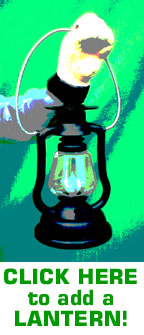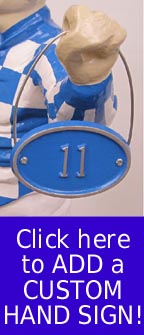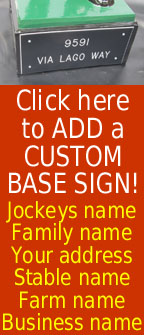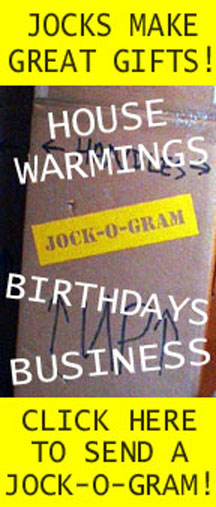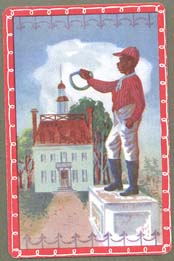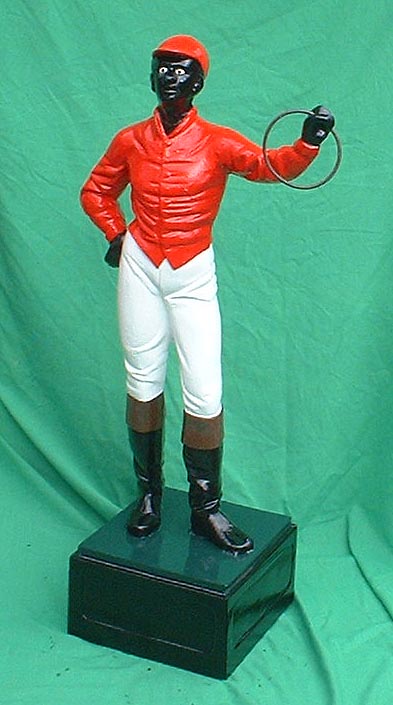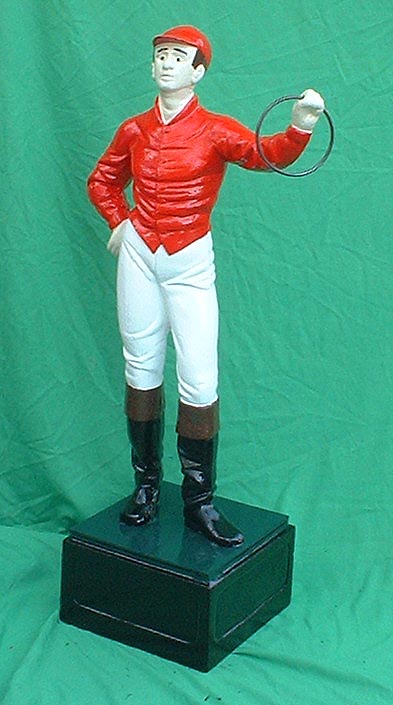After the civil war ended in 1865, all the iron foundries stopped beating plowshares into swords and started making
new products(mostly in the northern states- everything was destroyed in the south). The Champion Iron Works were established in Kenton, Ohio in 1876, and were one of the first to
take George Washington's original commissioned 1776 Lawn Jockey statue designs made popular in the south, and reinvent them into the popular "horse racing jockey" statues we see today. The irony of a "yankee" company
"stealing" an icon of the Old South and reinventing it is one of the more colorful aspects in the 3 century history of the American Lawn Jock.
Like it's Old South predecessors, the original "horse racing jockey" statues were depicted as African-american.
Influenced by the patriotism of the US Centennial in 1876 and by the running of the first Kentucky Derby in 1875(with 13 out of 15 jockeys being black),
this "original black face" style became very popular. However, the statue's face was designed so it could be painted in both black or white, foreshadowing the integration of American society over the next century.
The horse jockey design deleted the "caricature" features from older Jocks, and added realistic human features.
The sculpture was manufactured out of solid cast iron or zinc and went so far into detail as to include glass eyeballs!
Since paints were not that advanced in the 1800's, the original cast iron lawn jockeys were glazed with porcelain for a shiny appearance. Our high-gloss 2-coat paint jobs replicate this style on our 21st-century Original Jock collection!
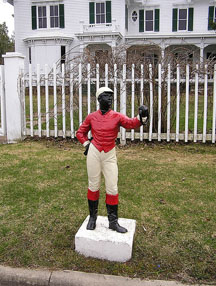
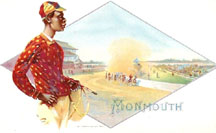
CLICK ON PHOTOS FOR LARGER VIEW
LEFT: Typical streetside location of jockey hitching post around 1880. When you built your house you set a hitching post at the curb. If you had any friends rich enough to own a horse and buggy, and they came to see you, they tied the horse and came in.
RIGHT: 1890 cigar box artwork featuring black horse racing jockey in typical racing silks. Almost all US jockeys in the 19th century were black.
Champion Iron's great success in manufacturing the new Lawn Jockey style led directly to the creation of a toy industry that transformed tiny Kenton, Ohio into the "Toy Capital of the World" from 1890-1930... making Christmas presents for a whole generation of American children.
Along with Lawn Jockeys, these iron toys from the turn of the century have recently experienced a resurgence in popularity as collectibles.
The amazing story of how the world's largest toy factory in Kenton, Ohio started with jail cells... and jockeys!
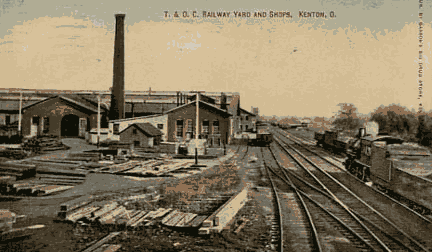
Small shops in Kenton, Ohio forged iron tools and farm implements since the 1840's. When the Champion Iron factory was built in the 1870's
along the railroad tracks it hired these iron craftsmen and became the town's largest employer with over 100 workers casting iron fences, cemetary gates, jail cells for wild west outlaws... and lawn jockeys.
Another small shop alongside Champion Iron called the Kenton Hardware Company made locks for the jails, and also used the same creative iron artisans who designed the jockeys to start making toy banks in the 1890's.
Kenton Hardware banks were a big hit at the 1893 Chicago World's Fair and
Kenton Hardware grew into the world's largest toy factory from 1890-1930.
The exquisite design and of metal artistry of the jockey statue that captivated your forefather's imagination in the 1800's lives on in our Original Lawn Jock collection.
Although jockey silks and caps usually have 2 or more contrasting colors in the cap vest and sleeves(like our Traditional Lawn Jock Collection), most of these original jockeys ended up being painted all red. This was probably due to the huge popularity of the Lawn Jock in the
medical community(that still exists today), and influenced by the establishment of the American Red Cross in 1881. The Original Jock looks like a "red cross". Doctors with traditional residences in upscale
neighborhoods started a trend that helped transform the Lawn Jock into a universal status symbol of power and privilege.
Original Jocks come in 2 versions: the original black-face and the "updated" white-face. The white-face jocks are by far the most popular today.
Original cast iron jocks used as hitching posts were made obsolete by the automobile and production stopped around 1913. Those that were not discarded ended up as home and business ornaments like on the
steps of the 21 Club in New York City in the 1920's.

Our Original Jocks copy this design from the late 1800's. Almost all of the remaining original 1875-1913 cast iron jocks of this design were melted during World War II metal recycling drives. They are extremely rare(and valuable) today.
Click on photo for larger view.
Our Original Jock replicas would make a great gift for any doctor, or collector of old-south, horse-racing or African-american memorabilia.
Each of our Original Jocks are artistically painted in heavy-handed brush strokes with thick, contrasting colors of paint. The statue arrives fully painted and fully assembled- just pull him out of the box and put him on the stoop!
A ring is included for the Original Jock's hand, but these Jocks also work well with our optional oil and solar lanterns(lantern sold separately-
CLICK HERE for more information).

